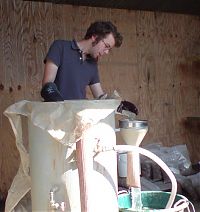Happy as a pig in...
- By: Steve Campion |
- Jun 13, 2008
- Share
- del.icio.us

For some reason a lot of you seem to be interested in dirt as you’re reading Fergal’s very good job of describing environmental sampling in droves. So much so that Lorna has bribed me into writing a thorough account of what it is we do with those lovely buckets of soil.
But lets not get ahead of ourselves, First we have to discuss how we decide which soil to sample. Certainly not every feature or layer needs to be sampled, that’s for sure.
For a start we predominately sample dated or dateable contexts. Why? Well it’s nice having the environmental evidence to tell us about the local environment of the site at that time….but what time? Without any dating, the facts can not be applied to the site. Though if a soil sample is particularly nice, sampling may still occur; possibly with a proxy date given. Of course when taking bulk samples you’re not just going to find ecofacts. Artefacts are common in finds and a nice few bits of pottery can suddenly date a sample and it’s context.
Generally speaking we take a series of bulk samples from a range of feature types in each phase/period of the site in order to characterise them. You see sampling has to be done for a reason. Is there a question that can be answered by sampling? Below are the actual palaeoenvironmental and palaeoeconomic themes for the site, as created by Dr Mike Allen, which the majority of the sampling aims to answer:
What evidence is there for the ritual use of plant foods in London’s Eastern Roman cemetery? What was the function of the medieval and post-medieval pits? Can they provide an indication of the nature and level of activity within the vicinity, and of the economy and status of the associated residents? What was the nature, economy and environment of the late medieval activity? What was the nature, economy and environment of the early post- medieval activity? What does the ‘cultivation soil’ really represent, and why is it preserved as a sealed horizon?
So once the samples are taken they are delivered to me in the Cambridge Office where the real fun begins. The samples are first put through a device called a ‘flotation tank’. Simply put, this is a barrel into which a constant supply of flowing water is pumped (see accompanying bad photo).
First, the sample is emptied onto a one millimetre mesh suspended just below the surface of the water. The flow of the water, coupled with manual working, breaks down the soil which passes through the mesh and settles at the bottom of the tank. What is left in the mesh after all the soil is washed away is called the heavy fraction and is basically all the inclusions in the soil that are too heavy to float , such as brick and bone. At the run off point, a 500 micron sieve is placed to catch all the floating material. This is called the light fraction, or flot, and is where the bulk of the palaeobotanical evidence will be found, such as charred seeds and charcoal. Though other typical floating items include small bones, and snails. The two separate fractions are then sorted with all relevant artefacts and ecofacts being extracted. These are then analysed and a report based on the inclusions wrote up.
But what can we ascertain from these inclusions? Lets examine animal bones:
Domestic animal bones or wild animal bones = farming or hunting.
Migratory animal bones present on site = knowledge that the site was occupied in that animals period
Butchery evidence on bones = technology of meat preparation and tools
Percentage of males to females/young to old of cattle = dairying, meat production
Species of animal bones = indicator of environment
How the animal was disposed = Certain disposals hint at ritualistic actions
And so on.
Hopefully by now you realise that environmental archaeology is great…
